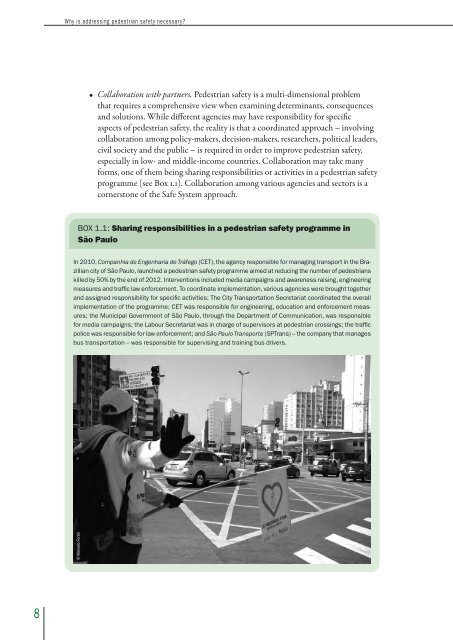Pedestrian safety - Global Road Safety Partnership
Pedestrian safety - Global Road Safety Partnership
Pedestrian safety - Global Road Safety Partnership
You also want an ePaper? Increase the reach of your titles
YUMPU automatically turns print PDFs into web optimized ePapers that Google loves.
Why is addressing pedestrian <strong>safety</strong> necessary?<br />
• Collaboration with partners. <strong>Pedestrian</strong> <strong>safety</strong> is a multi-dimensional problem<br />
that requires a comprehensive view when examining determinants, consequences<br />
and solutions. While different agencies may have responsibility for specific<br />
aspects of pedestrian <strong>safety</strong>, the reality is that a coordinated approach – involving<br />
collaboration among policy-makers, decision-makers, researchers, political leaders,<br />
civil society and the public – is required in order to improve pedestrian <strong>safety</strong>,<br />
especially in low- and middle-income countries. Collaboration may take many<br />
forms, one of them being sharing responsibilities or activities in a pedestrian <strong>safety</strong><br />
programme (see Box 1.1). Collaboration among various agencies and sectors is a<br />
cornerstone of the Safe System approach.<br />
BOX 1.1: Sharing responsibilities in a pedestrian <strong>safety</strong> programme in<br />
São Paulo<br />
In 2010, Companhia de Engenharia de Tráfego (CET), the agency responsible for managing transport in the Brazillian<br />
city of São Paulo, launched a pedestrian <strong>safety</strong> programme aimed at reducing the number of pedestrians<br />
killed by 50% by the end of 2012. Interventions included media campaigns and awareness raising, engineering<br />
measures and traffic law enforcement. To coordinate implementation, various agencies were brought together<br />
and assigned responsibility for specific activities: The City Transportation Secretariat coordinated the overall<br />
implementation of the programme; CET was responsible for engineering, education and enforcement measures;<br />
the Municipal Government of São Paulo, through the Department of Communication, was responsible<br />
for media campaigns; the Labour Secretariat was in charge of supervisors at pedestrian crossings; the traffic<br />
police was responsible for law enforcement; and São Paulo Transporte (SPTrans) – the company that manages<br />
bus transportation – was responsible for supervising and training bus drivers.<br />
© Marcelo Fortin<br />
8






